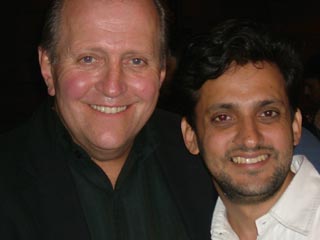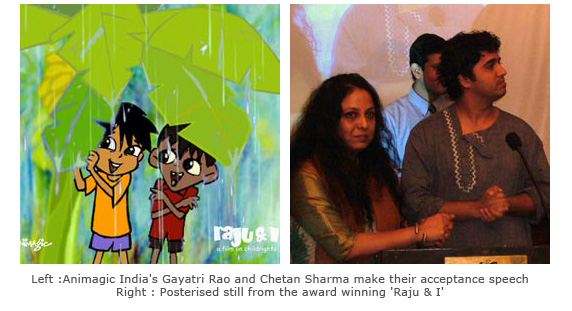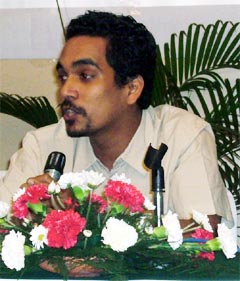Is the Indian animation industry showing signs of unity after all?

For Indian animation professionals, yesterday it seemed as if all roads were leading to the Mayfair Rooms at Worli in Mumbai. Supported by VCL, Rhythm & Hues, TASI and APAI,The ASIFA India organised International Animation Day celebration was well attended.
Present amongst the 100+ crowd were father of Indian animation Ram Mohan, eminent film maker Govind Nihalani, ASIFA India president Bill Dennis and VP Shrirang Sathaye, Animagic India’s Gayatri Rao, Chetan Sharma and Romel Dias, NID’s Rajesh Chakrabarty, TATA Elxsi GM K Chandrashekhar along with creative head Pankaj Khanpur, Rhythm & Hues India’s Saraswathi Balgam and Prashant Babu along with colleagues, 2nz’s Bhimsain Khurana, Kireet Khurana, Kushal Ruia, Uma with colleagues, Sanjiv Waeerkar and Charmi Chedda from Dream Forest Films, Milestone Interactive’s Sachin Naik, Animation Bridge Biren Ghose, Padmalaya’s Rajiv Sangari, Vaibhav Studios’ Vaibhav Kumaresh, Animation expert Ranjit Singh, 3D and FX expert Jai Natrajan, Indiantelevision.com CEO Anil Wanvari and Business development head Anoop Wanvari and APAI’s Bhuvan Lal.
Kickstarting the evening’s proceedings, ASIFA India president Bill Dennis welcomed the audiences and gave an insight into the selection process for the ASIFA India best animation award for 2003. Dennis proudly informed the audience that some of the nominated films would be screened at ASIFA celebrations across the world.
VCL GM K Chandrashekhar then gave a sincere talk, urging the audience to look beyond the hype being generated around the industry. He asked fellow professionals to collectively focus and fight issues that threatened to hamper progress.

KC’s talk was followed by the handing over of the ASIFA India best animation of 2003 Trophy. Amongst the many nominees shortlisted, the ASEEMA produced, Animagic India created Raju & I yet again emerged the winner. The sensitively directed and scripted film is so effective that after a while the viewers aren’t aware that they are watching an animated film. The animation and illustration too is beautiful. It is no surprise that Raju & I has been constantly bagging awards wherever it is screened. NID’s Rajesh Chakrabarty also recieved an award for his short Dhak.
The screenings and awards ceremony was followed by a blue ribbon panel discussion on critical issues facing the industry. The panelists included veteran animator and Graphiti Multimedia Chairman Ram Mohan, IDC Animation head Professor Shilpa Ranade, APAI head Bhuvan Lal, 2nz CEO Kireet Khurana, Rhythm & Hues India director Prashant Buyayla, Indiantelevision.com CEO and Reed Midem India representative Anil Wanvari and TATA Elxsi GM K Chandrashekhar. The discussion was moderated by Bill Dennis.

Dennis got the panel discussion off on a high note by asking those on the dias what was the one thing that Indian animation needs to do to be able to deliver on its potential. Wanvari’s view was that the industry needs to go for a major image makeover.
“Internationally, the Indian animation industry’s image has taken a beating,” he said. “Some companies have not delivered on their commitments. We need to put up a common front, we need to be seen as creators of quality content, not as just service contractors. It is sad that at markets like Mipcom we see representatives of good Indian animation companies scrambling around like salesman, beating the aisles, soliciting work. We need to put up a better front.”
Lall agreed and added that the industry needs a mindset change. “India’s animation producers need to think differently.”
Chandrashekhar said that the one major thing that the industry needs is money, “There’s a paucity of money,” he said. “Good productions cost a lot and there’s not enough money going around.”
Wanvari’s rejoinder was that it is not money alone that Indian companies need. Large groups such as Zee TV did not do well with a live action-cum-animation movie such as Bhagmati, despite the fact that good investments were put in behind the film. The panelists agreed but said that the heart of any creative visual product is a good story, good content.
Kireet said that the need of the hour is original content, and his company was working towards that.
Amongst various other topics debated during the discussion, was the issue of poaching. VCL’s K Chandrashekhar proposed an understanding amongst studio heads wherein animators that jumped jobs in between projects be blacklisted. A majority of the panelists however wouldn’t agree to this.
Rhythm & Hues Prashant stated that if people were motivated and given challenges they would remain involved and wouldn’t jump jobs. Professor Shilpa Ranade’s viewpoint was that since most of the work being done in India was the outsourced work for hire kind, it was easy for animators to jump jobs. “The lack of personal animation is one big reason why the studios face this problem” she said.
K C then spoke about the high costs of animation and how studios would have to cope. Indiantelevision CEO Anil Wanvari coming from a strong media and entertainment background said that there were potential financers willing to invest. Said Wanvari,” I see a lot of film makers getting curious about animation. Yashraj Films’ Hum Tum is one such example. In the future I see mainstream producers looking at animation”
Kireet Khurana who has 3 original animated TV shows to his credit as well as merchandising and comic publishing experience behind him, spoke on how the industry needed to get together and share knowhow and experience. “The industry needs to unite and share know how, we need to define ways and techniques in which we can generate additional revenue out of IP and meet the high costs of development” said Kireet.

How united is the industry? Bill dennis stated that “Last year at a trade fair, the specially set up India pavilion was empty” the reason, said Bill, was that “there is no trust whatsoever amongst studios out here.”
APAI’s Bhuvan Lal argued that the studio heads were out on meetings. Bill however concluded the arguement saying that studio owners had themselves confided in him that they didn’t trust each another.
Indiantelevision.com CEO who is representative for Reed Midem which organises trade fairs like MIPCOM and ATF expressed hope saying, “I hope that the Indian animation industry comes together at fairs like Mipcom and MipTV and makes a good mark internationally”
Concluding the discussion which extended beyond the schedule, Dennis asked the panelists as to where they saw Indian animation ten years hence. Thankfully, all the panelists seem to agree this once, things they said were improving and surely there would be lot of original as well as high quality work coming out of India. “I know more than 20-25 people who are raring to go and start their original projects. They are just waiting to get some positive signals” said Kireet.
As is the case with debates and discussions, there were more questions than answers that sprung up. Debates and meetings like these however are useful in the sense that they constantly underline issues that need to be dealt with, and move grudging minds towards more flexible and positive atitudes.
Every creative industry has 2 kinds of professionals, the creative ones and the business and management ones. Between these 2 kinds there always exists a classic difference in perspective and outlook.Creativity was celebrated by the screening of the award winners films and the awards ceremony. The panel discussion that followed was about the business of animation.
The heaviness of the discussion over, the party that followed had the animators amongst the crowd hanging loose, mingling, networking and discussing yet another favourite topic – Animation, the art.
Speaking to Animation ‘xpress, Charmi Chedda an animator and creative writer from Dream Forest said “We don’t understand or care for the numbers, we are artists, lets talk about the art, lets talk about animation” Her sentiments were echoed by the other animators too.
But that’s another story, for another day.
Till then, Happy International Animation Day!

